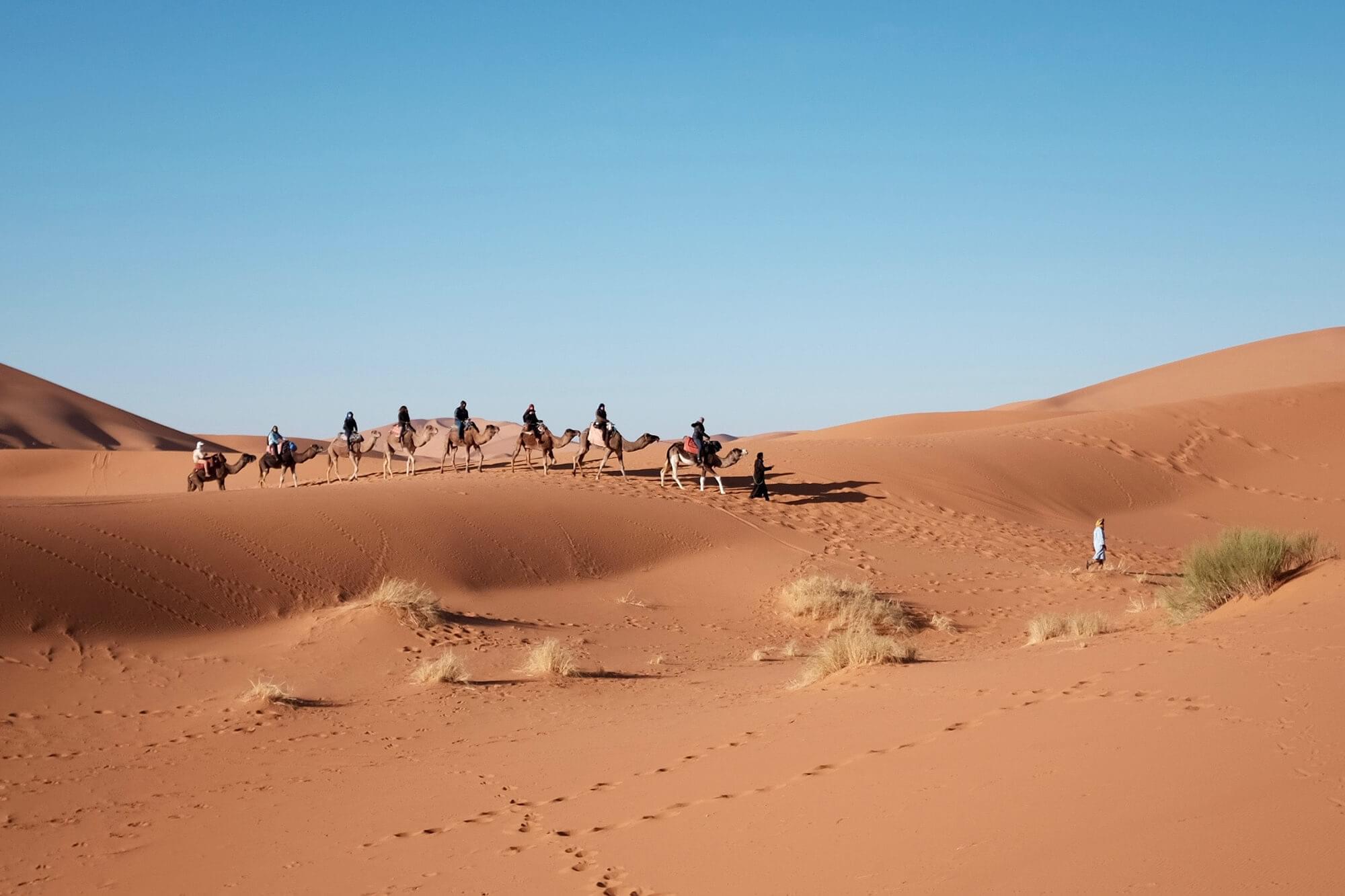Deserts are difficult places to live. These landscapes, which are hot during the day and cold at night, put their inhabitants to the test. Desert creatures have evolved adaptations to help them survive and thrive in these harsh conditions. Many of these creatures never need to drink and have skin or scales that allow them to store what little water they need; others have evolved to move and be active only at night to avoid the harsh sun. Here are some of the most strange desert animals:
1. Fennec fox
Fennec foxes are the cutest desert animals (Vulpes zerda). These tiny canids are shorter than domestic cats, measuring 14 to 16 inches (35.6 to 40.6 centimeters) without their tails, but they have enormous ears that can grow to be 4 to 6 inches (10.2 to 15.2 cm) long. These ears assist foxes in shedding heat and listening for prey beneath the sand. According to the Smithsonian National Zoo, when foxes hear the sound of rodents, insects, or other small animals they prey on, they use all four paws to dig out their prey in a shower of sand (opens in new tab).
Sponsered6
Fennec foxes are well-adapted to desert life in Africa and Arabia. Their pale fur camouflages them against the sand and grows on the bottoms of their feet to provide traction while running in the sand as well as protection from the hot desert surface. When the temperature rises, foxes can pant up to 690 times per minute to keep cool. Fennec foxes dig elaborate burrows to avoid the sun during the hottest part of the day.
2. Desert scorpion with hair
The hairy desert scorpion (Hadrurus arizonensis) is a standout among the many scorpion species that live in deserts. According to Utah’s Hogle Zoo(opens in new tab), these scorpions can grow to be 4 to 7 inches (10.2 to 17.8 cm) long, making them the largest scorpions in North America. Hairy desert scorpions fluoresce under ultraviolet (UV) light, despite their drab olive-green color. No one knows why scorpions fluoresce, but taking a UV light into the desert on a summer night, when they are most active, is the best way to find these shy nocturnal predators.
Sponsered6
Hairy desert scorpions are found in the Sonoran and Mojave deserts of North America, as well as Nevada and Utah. Male and female hairy desert scorpions lock pincers in a mating dance that resembles a wrestling match when looking for a mate. In fact, if the male does not flee immediately after depositing his sperm, he may become his mate’s next meal.
Females carry their young for six to twelve months, giving birth to up to 35 babies who ride on their mother’s carapace until they are old enough to hunt on their own. Fortunately for humans, desert hairy scorpions prefer to flee rather than sting, and their venom is mild. Most people compare the sting to that of a bee.
3. Desert ironclad beetle
Sponsered6
The desert ironclad beetle (Asbolus verrucosus) is a tank of an insect. Its powder-blue color comes from a waxy coating that helps the beetle retain moisture in the dry Sonoran desert. The bumps on the beetle’s shell give it an armored appearance that is even tougher than it looks. The ironclad beetle subfamily is known for its ultra-strong exoskeleton — it’s so strong, these beetles can shrug off being stepped on by a human, according to the University of Wisconsin, Milwaukee(opens in new tab).
Desert ironclad beetles are also known as “death-feigning beetles” for their defensive behavior in the face of threats. When alarmed, the beetles roll over and play dead, according to the Cincinnati Zoo and Botanical Garden(opens in new tab). They eat plants and decaying organic matter, and — like many desert denizens — rarely, if ever, need to drink.
4. Harris’s hawk
Sponsered6
Harris’s hawks (Parabuteo unicinctus) are unique among falcons. These impressive red-winged raptors sometimes hunt in groups, working together to pursue their prey through Arizona’s Sonoran desert’s bushes, thickets, and saguaro cactuses. Lizards, other birds, and small desert mammals such as kangaroo rats and ground squirrels are eaten by the birds. According to the conservation organization Audubon, when they catch large prey, they will share the meat with their fellow hunters (opens in new tab).
These birds frequently raise their young in groups. Two males may mate with a single female, and the resulting hatchlings are raised peacefully by the trio. Hawk siblings also assist one another; an older brood from earlier in the season may remain to bring food to younger broods.
5. Screaming hairy armadillo
Sponsered6
Screaming hairy armadillos are less cute than fennec foxes but no less well-adapted to their desert environment (Chaetophractus vellerosus). When threatened, these armadillos make a terrible cry that sounds similar to the wails of a newborn human baby. According to research published in 2019(opens in new tab), these screams are intended to startle predators or attract other predators to the scene, possibly distracting an attacker and allowing the armadillo to flee.
Armadillos with screaming hair weigh only 1.9 pounds (0.86 kilograms). According to the Smithsonian National Zoo, they live in the Monte desert of Argentina, Bolivia, and Paraguay, preferring areas with loose, sandy soil where they can dig burrows (opens in new tab). Armadillos rarely require water. Their kidneys are extremely efficient, and they get the majority of the water they require from the plants they consume. Because the desert is a waste not, want not environment, screaming hairy armadillos are opportunistic eaters, consuming insects and small animals such as lizards and rodents.
6. Sand cat
Sponsered6
The desert sand cat is a softer, fuzzier desert denizen (Felis margarita). It is the only cat species that lives in true desert habitats. The Sahara desert, the Arabian Peninsula, Turkmenistan, Kazakhstan, and Uzbekistan are all home to desert sand cats. Sand cats, despite their striking resemblance to fluffy domestic cats, are elusive and rarely seen by humans. According to the International Society for Endangered Cats (ISEC) Canada, they are secretive and difficult to track (opens in new tab).
When researchers attempted to observe these animals in the wild, they discovered that the cats’ fur-lined paws left no tracks and that their light-colored coats made them difficult to spot. Furthermore, at night, the cats crouched low and closed their eyes against searchlights, concealing their reflective retinas.Sand cats are sly hunters capable of killing snakes, desert rodents, and lizards. Their mating call is similar to a dog’s bark.
7. Pink cockatoo
Sponsered6
Colorful birds are commonly found in lush, tropical rainforests and are scarce in arid regions — unless you live in Australia’s interior. The pink cockatoo (Lophochroa leadbeateri), which lives in the semi-arid and arid Australian Outback, is one of the continent’s most beloved bird species.
The pink cockatoo, distinguished by its showy orange-and-yellow crest and blush-shaded body, is divided into two subspecies, one found in western-central Australia and the other in the east, according to the Australian Museum (opens in new tab). These lovely birds subsist on seeds and insects. According to the Australian Foundation for National Parks and Wildlife (opens in new tab) (FNPW), they mate for life and can be seen prancing on tree branches, bobbing their heads up and down to attract mates.
According to FNPW, these iconic Australian birds have a variety of names and nicknames. They’re also known as Leadbeater’s cockatoos, desert cockatoos, cocklerinas, chockalotts, and — most adorably — wee jugglers, after an early English explorer who wrote about them for a global audience.
Sponsered6
8. Desert pupfish
Fish in the desert? Desert pupfish (Cyprinodon macularis) are small, silvery fish that can survive remarkably well in parched conditions. Pupfish have evolved to thrive in water that flows through arid regions. They’re found in California’s Salton Sea and its tributaries, and in waterways along the lower Colorado River in Mexico.
To survive in the desert’s meager or brackish water sources, these fish must be extremely resilient. According to the California Department of Fish and Wildlife, pupfish have special adaptations that allow them to survive in conditions that would kill most fish (opens in new tab). Pupfish can live in a wide range of water conditions, from fresh to 70 parts per thousand salt (most of the ocean is between 34 and 26 parts-per-thousand salt). They can survive in temperatures as low as 40 degrees Fahrenheit (4.4 degrees Celsius) and as high as 108 degrees Fahrenheit (42.2 C). They can even survive in water with as little as 0.1 parts per million (ppm) oxygen (most warm-water fish require 5 ppm oxygen to survive, according to Florida’s Center for Aquatic and Invasive Plants(opens in new tab).
Sponsered6
9. Thorny devil
No list of strange desert animals would be complete without mentioning lizards. No lizard tribute would be complete without mentioning the thorny devil (Moloch horridus), the sole species in the genus Moloch, named after an ancient, sacrifice-demanding god worshiped by the Caanites and mentioned in the Hebrew Bible. Only in Australia can you find a thorny devil. They can grow to be just over 8 inches (21 cm) long from nose to tail and are covered in sharp spines that protect them from predators.
Thorny devils, too, have two heads. The first is a false head, a protuberance on the devil’s neck. When threatened, a thorny devil lowers its true head and displays the false head as a decoy. According to Bush Heritage Australia, thorny devils have a distinct jerky walk that may confuse predators (opens in new tab).
Sponsered6
According to Bush Heritage Australia, as frightening as thorny devils appear, they are only a threat to ants, which eat them by the thousands with their sticky tongues. These desert inhabitants “drink” through their skin, collecting dew and moisture from the sand through tiny channels between their scales. These straw-like channels that direct precious drops to the lizards’ mouths are just one example of the inventive hydration mechanisms that keep animals alive in the world’s driest places.
Sponsered6




